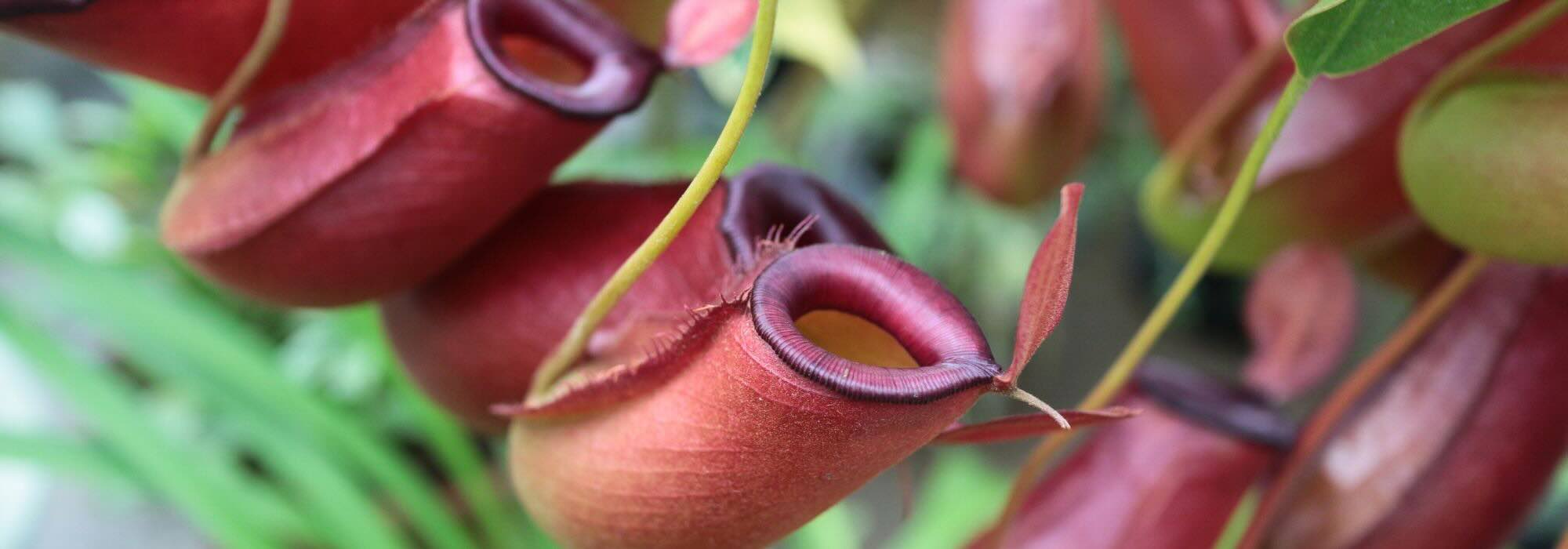
Drosera, Dionaea, Sarracenia... the major families of carnivorous plants
Getting to know this fascinating family better
Contents
Strange, fascinating, sometimes slightly unsettling… Carnivorous plants leave no one indifferent. They intrigue as much by their appearance as by their way of life, halfway between plant and living trap. Unlike most plants, they do not simply draw their nutrients from the soil: they seek them elsewhere… from insects.
To survive, some have developed remarkably effective hunting techniques. But not all of them capture their prey in the same way!
In this article, explore the major families of carnivorous plants such as Dionaea, Drosera, Sarracenia, and a few other more discreet ones, to understand how they function, where they live, and how to cultivate them at home. Ready for a journey into the heart of carnivorous plants?
Why have some plants become carnivorous?
A carnivorous plant hasn’t chosen the easiest path: instead of simply drawing nutrients from the soil, it has developed astonishing strategies to attract, capture, then digest small prey, most often insects. But why such an adaptation?
The answer lies in the environments where these plants evolved: acidic turf moors, marshy soils, areas very poor in nutrients. In these extreme environments, roots cannot find enough nitrogen or phosphorus, two nutrients essential for growth. Faced with this deficiency, certain species bypassed the problem by turning to another source: the animal world.
This evolution gave rise to an incredible diversity of trapping mechanisms. Depending on the family, we mainly distinguish three types of traps:
-
the active traps, like those of Dionaea, which snap shut rapidly on their prey;
-
the sticky traps, as seen in Drosera, whose leaves are covered in viscous mucilage;
-
the passive traps, like the pitchers of Sarracenia, which capture prey through simple fall.
This fascinating adaptation shows just how inventive plants can be when it comes to survival.
Read also
What do carnivorous plants really eat?Carnivorous plant Dionaea – The iconic Venus flytrap
When we think of a carnivorous plant, it’s often Dionaea muscipula, the famous “Venus flytrap”, that comes to mind. Native to the wetlands of North and South Carolina in the United States, this plant has become a true star, as much for its unique appearance as for its spectacular trapping mechanism.
A trap worthy of a science fiction film
The Dionaea has modified leaves shaped like jaws lined with cilia. Inside, small sensitive hairs trigger the trap to close when touched twice, or by two different hairs, within 20 seconds. This clever system prevents unnecessary closures due to rain or debris.
Once prey is captured (often a fly or small spider), the plant seals its trap tightly and begins digestion using enzymes. This phase lasts several days, after which the trap reopens. The indigestible remains, often bits of exoskeleton or wings, remain visible inside until rain or wind carries them away… or until the trap eventually decomposes.
A plant that requires some care
The Venus flytrap is spectacular, but somewhat demanding to grow. It needs:
-
a very poor substrate, such as blonde turf + sand or perlite, without fertiliser;
-
very pure water, such as rainwater or osmosis water;
-
maximum direct light, at least 5-6 hours per day;
-
and a winter dormancy period, with cooler temperatures and less light.
With these conditions met, it can live for several years, produce new traps, and even flower in spring.
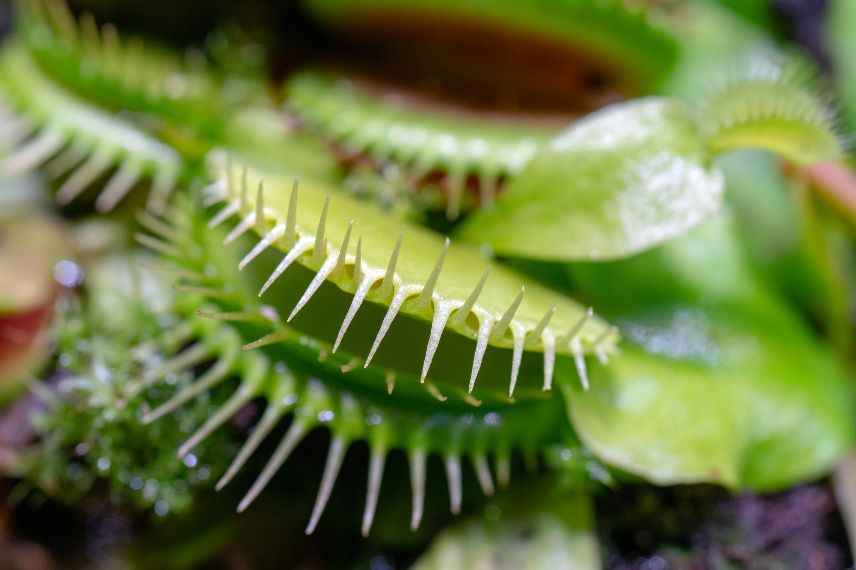
Dionaea or Venus flytrap
Carnivorous plant Drosera – The sticky tentacles
While Dionaea catches attention with its rapid jaws, Drosera impresses with its delicacy… and efficiency! These plants form one of the largest genera of carnivorous plants, with nearly 200 species found worldwide, from Canada to Australia.
Leaves Adorned with Deadly Pearls
Drosera are recognisable by their leaves covered in glandulous hairs that secrete a sticky, glistening liquid resembling dew. These droplets attract insects, which quickly become trapped as they struggle to break free. The more they move, the more entangled they become.
Some species, like Drosera capensis, even curl their tentacles to better ensnare their prey. Once immobilised, the plant releases digestive enzymes to extract nutrients.
A Wide Variety of Forms and Habitats
Drosera can be:
- rosette-forming at ground level (like Drosera rotundifolia, typical of European turf moors),
- upright on a stem (like Drosera capensis, very popular among enthusiasts),
- or even climbing (like some astonishing Australian species).
Each species has its specific needs, but generally, they prefer:
- an acidic and nutrient-poor substrate (turf + perlite),
- a humid environment,
- and plenty of light without direct scorching sun.
They are an excellent starting point for beginners, as some species are very tolerant and prolific.
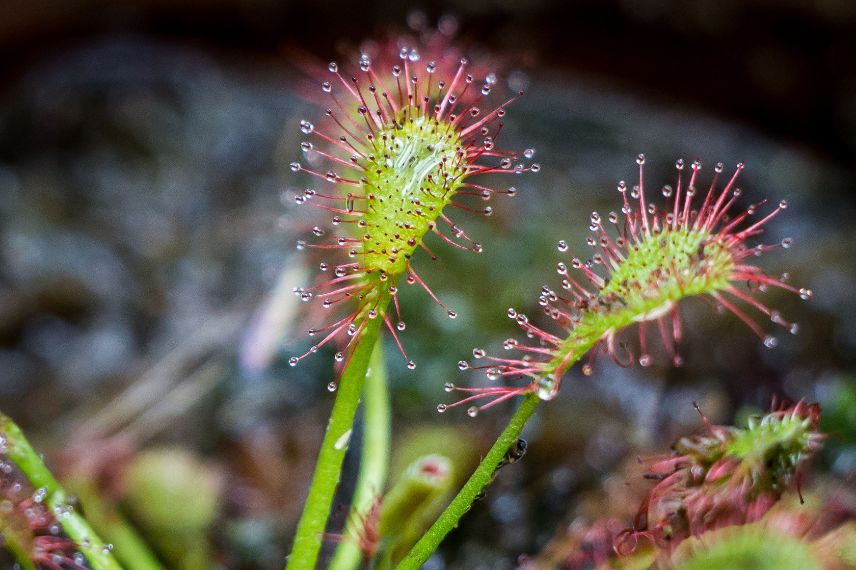
Droseras, simple enough to start with carnivorous plant cultivation
Carnivorous plant Sarracenia – The elegant trumpets
With their tall, colourful pitchers reaching skywards, Sarracenia certainly don’t go unnoticed. Native to North America, these carnivorous plants stand out for their elegance… and their deadly efficiency.
Passive but ruthless traps
The leaves of Sarracenia are transformed into deep tubes, often streaked with red and edged with nectar to lure insects. The upper rim (or “operculum”) prevents rain from filling the pitcher while guiding prey towards the entrance.
Once inside, the insect slips on a waxy surface, falls to the bottom and cannot climb back up due to downward-pointing hairs. It is then slowly digested by enzymes or natural bacteria present in the pitcher’s water.
A great diversity of shapes and colours
There are several species of Sarracenia, such as:
- Sarracenia purpurea, with low, stocky pitchers often filled with rainwater;
- Sarracenia flava, tall and yellow, capable of exceeding 80 cm;
- or Sarracenia leucophylla, spectacular with its white patterns veined in red.
All share a love of sun (6 to 8 hours per day) and a very poor, consistently moist substrate.
Easy to grow outdoors
Sarracenia thrive particularly well in outdoor pots on a balcony or terrace. They tolerate cold well (down to -10°C for some species) and appreciate a proper winter dormancy, essential for their health.
With good rainwater watering and a little patience, they quickly become garden stars.
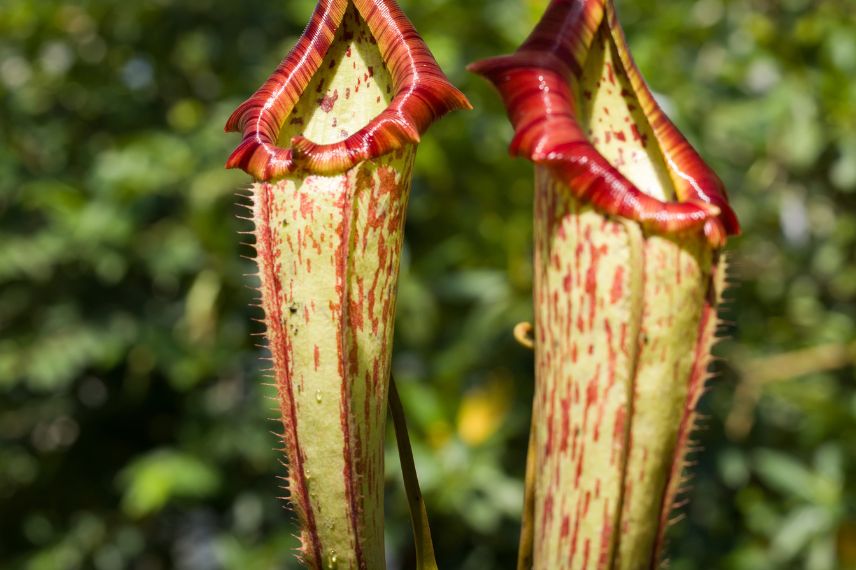
Sarracenias, with their long tubes
Other carnivorous plant families to discover
While Dionaea, Drosera and Sarracenia are the most well-known, the world of carnivorous plants is far more extensive. Some lesser-known families also abound with botanical wonders, sometimes even more surprising!
Nepenthes – The Hanging Pitchers of the Tropics
Nicknamed “pitcher plants”, the Nepenthes mainly originate from Southeast Asia and grow in tropical environments. They produce long stems and pitcher-shaped traps that hang suspended, sometimes as large as a bottle!
-
Each pitcher is filled with digestive fluid.
-
Insects slip along the smooth rim and fall into the trap.
-
Some species even catch small vertebrates!
They are often grown in heated greenhouses or terrariums, as they require warmth, constant humidity and good air circulation.
Cephalotus – The Little Australian Trap
Native to southwestern Australia, the Cephalotus follicularis resembles a cross between a miniature Sarracenia and a succulent plant. Its small, stout pitchers are both cute and effective.
This is a more demanding plant that enjoys:
-
a temperate and stable climate,
-
a well-draining substrate,
-
and minimal watering in winter.
Heliamphora – The Venezuelan Cloud Catchers
The Heliamphora, or “sun marsh plants”, live in the Tepuy — Wikipédia (misty high plateaus) of Venezuela and Guyana. They resemble Sarracenia but with slimmer pitchers, often open and without an operculum.
They require:
-
consistently high humidity,
-
cool temperatures at night,
-
and plenty of gentle light.
They are mainly for advanced enthusiasts, but their grace makes the effort worthwhile!
Utricularia – The Invisible Traps Underwater or Underground
Less well-known but equally astonishing, the Utricularia, or bladderworts, form the largest genus of carnivorous plants, with over 200 species! They are distinguished by their tiny bladder-shaped traps, called utricles, which literally suck in their prey (small aquatic or soil-dwelling invertebrates) in a fraction of a second.
-
Some live underwater, like Utricularia vulgaris, commonly found in ponds.
-
Others grow in terrestrial environments, sometimes in moss or turf.
-
As a bonus, their flowers are often delicate and fine.
They are ideal for humid terrariums or natural ponds.
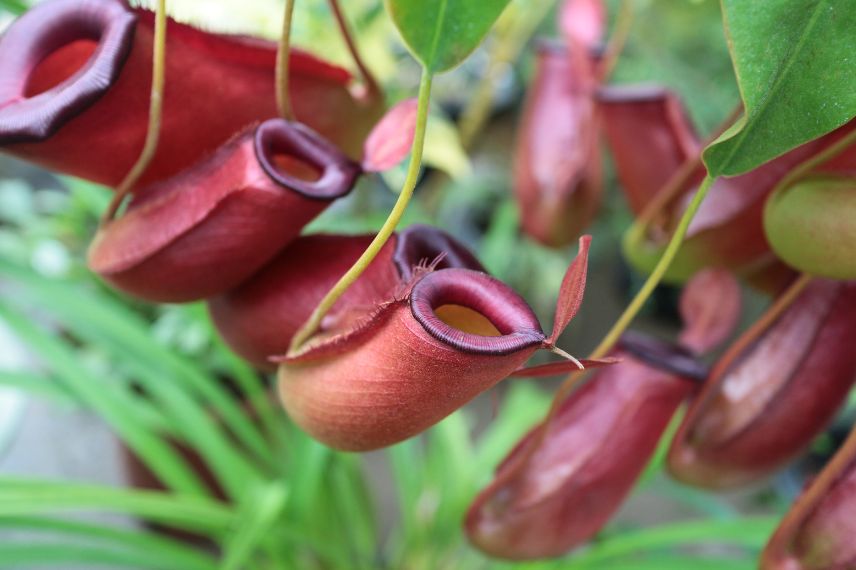
The pitchers of Nepenthes
- Subscribe!
- Contents
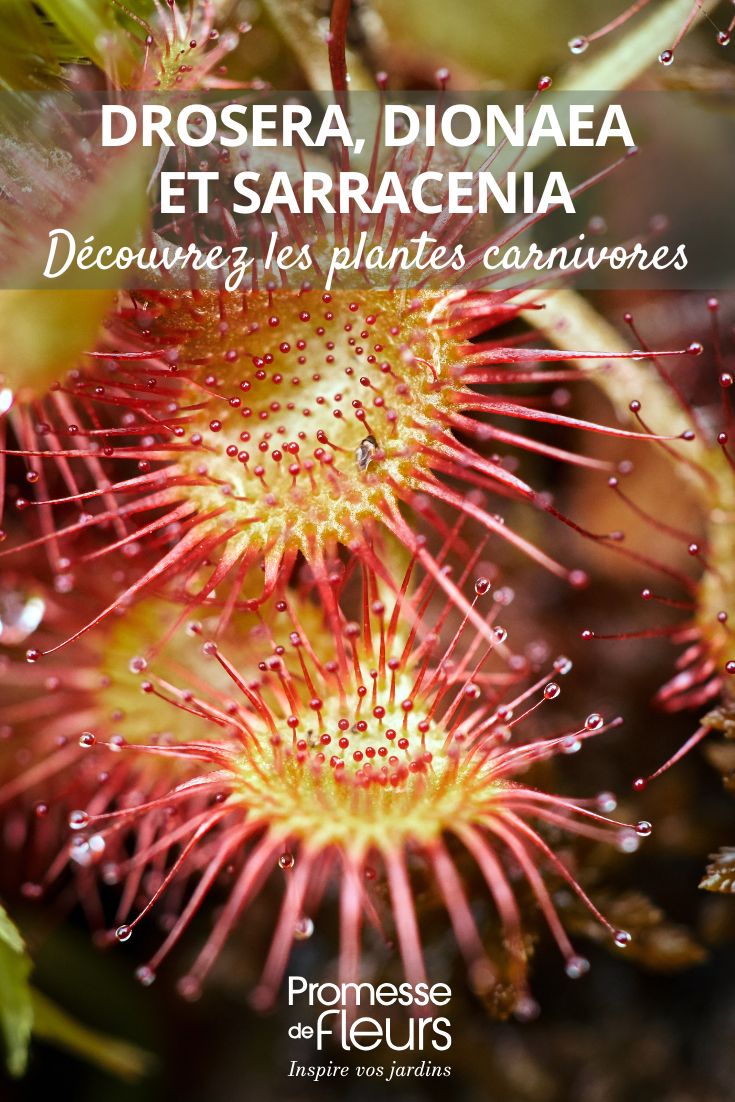































Comments